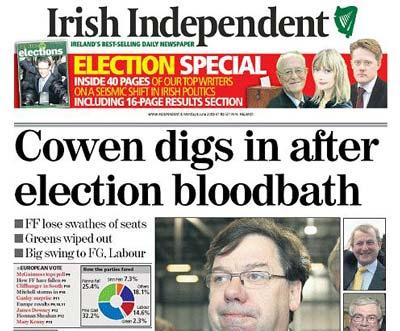Serial 'churnalism' at Irish Times and Irish Independent

A study carried out in Dublin City University shows that the Irish print media depends heavily on public relations material for its daily news content. By Joe Galvin
The study, carried out by postgraduate students in 2010, found that between 11.6% and 21% of newspaper stories across eight major daily publications were mainly or entirely generated by public relations material, and that between 32% and 50% of all stories contained elements of public relations material. The worst offender was the Irish Times (21% of stories comprising all or mainly public relations material) with the Evening Herald scoring best (11.6% comprising all or mainly public relations material).
The other newspapers examined were the Daily Mirror (12%), the Irish Examiner (16%), the Daily Mail (13%) and the Irish Sun (13.6%). All the figures for the Irish Independent are currently unavailable, but the students found that 46% of all stories in the Independent contained public relations material - a figure which is broadly in line with the other newspapers.
The figures confirm that newspapers are struggling to find content to fill their pages each day. In an era where journalists are often expected to write up to ten stories a day, the temptation to lift information from wire sources such as Reuters or directly from press releases has become too great.
Nick Davies wrote in Flat Earth News - a critique of modern journalism - that newspapers were awash with what he called "churnalism" which involved "journalists who are no longer out gathering news but who are reduced to passive processors of whatever material comes their way, churning out stories, whether real event or PR artifice, important or trivial, true or false".
Davies focussed largely on British journalism, but this study shows that the Irish news media are also riddled with PR - and it is very easy to find. Take, for example, this story in the Irish Independent yesterday (18 November 2010). There is little news value, and the 'news' is entirely generated through PR artifice. This story has no problem making it into the pages of our largest newspaper, at a time when our country is in the throes of its most severe crisis since independence.
But this is just one obvious example of hundreds throughout our news media on any given day. There is no question that the critical independence of our media is under severe threat, and as the money grows increasingly tight the tide of churnalism will grow ever more difficult to stem. Journalist have no time to check facts, no time to corroborate evidence and, often, no time to even leave their desks. This is not journalism, and as one of the leading influences in the country, this can lead to serious problems.
Take, for example, the fact that our newspapers comprehensively failed to challenge the prevailing orthodoxy during the boom. There are many reasons why (including protecting revenue from property advertising), but the decision to opt for the profitability of quick-fix journalism instead of exerting resources on investigation and in-depth reporting is undoubtedly a major factor. Our news media failed to be sufficiently critical during the boom years. The cost of this failure is now all too clear.
The lesson? Don't believe everything you read in the papers.
Irish Times
40% appear to have PR
21% all/mainly PR
Daily Mirror
32% appear to have PR
12% all/mainly PR
Irish Examiner
50% appear to have PR
16% all/mainly
Irish Independent
46% appear to have PR
Daily Mail
33.2% appear to have PR
12.9% all/mainly
Irish Sun
38% appear
13.6% all/mainly
Evening Herald
43% appear to have PR
11.6% all/mainly
(More here from an earlier study of the Evening Herald by bloggers at Tuppenceworth.ie)
Clarification of "appears to have PR" in the statistics above.
'Appears to have' is based on signs that suggest (rather than prove) that an article may be derived from pre-packaged content. These signs are derived from studies that were undertaken in the UK. Indications of such a piece are quotes that are unattributed, for example, or referencing "a newspaper reporter" (without stating their name). And other criteria - see more in the Flat Earth news link above. When PR is paraphrased and edited into house style it is more difficult to verify.
However, all/mainly refers to articles that are proven to be regurgitated press releases and pre-packaged content. This was established by comparing the texts of articles with other articles and PR statements.
Therefore the value of the 'Appears to have' percentages is to suggest that the base value may be higher.
This research was undertaken by approximately 40 students, including some journalists, who assessed over 10,000 news articles over the course of two weeks. Between six and seven students worked separately on each newspaper.
Malachy Browne
